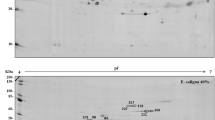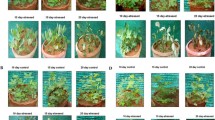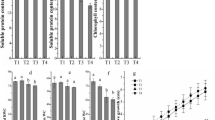Abstract
Lupinus albus plants can withstand severe drought stress and show signs of recovery 24 h after rewatering (RW). Two-dimensional gel electrophoresis was used to evaluate the effect of water deficit (WD) on the protein composition of the two components of the lupin stem (stele and cortex). This was performed at three distinct stress levels: an early stage, a severe WD, and early recovery. Protein characterisation was performed through mass spectrometric partial sequencing. Modifications in the protein expression were first noticed at 3 days of withholding water, when the plant water status was still unaffected but some decrease in the relative soil water content had already occurred. An increase in serine proteases, possibly associated with WD sensing, was an early alteration induced by WD. When the stress severity increased, a larger number of stem proteins were affected. Immunophilin, serine protease and cysteine protease (well-known components of animal sensing pathways) were some of these proteins. The simultaneous expression of proteases and protease inhibitors that reacted differently to the stress level and to RW was found. Although the level of protease inhibitors was significantly raised, RW did not cause de novo expression of proteins. Many amino acid sequences did not match known sequences of either protein or expressed sequence tag databases. This emphasises the largely unknown nature of stem proteins. Nevertheless, some important clues regarding the way the lupin plant copes with WD were revealed.




Similar content being viewed by others
Abbreviations
- DAW:
-
Days of withholding water
- MS:
-
Mass spectrometry
- RWC:
-
Relative water content
- RSWC:
-
Relative soil water content
- 2DE:
-
Two-dimensional electrophoresis
- RW:
-
Rewatering
- WD:
-
Water deficit
- Ψ pd:
-
Leaf water potential at pre-dawn
References
Bantignies B, Seguin J, Muzac I, Dedaldechamp F, Gulick P, Ibrahim R (2000) Direct evidence of ribonucleolytic activity of a PR-10-like protein from white lupin roots. Plant Mol Biol 42:871–881
Bartels D, Salamini F (2001) Desiccation tolerance in the resurrection plant Craterostigma plantagineum. A contribution to the study of drought tolerance at molecular level. Plant Physiol 127:1346–1353
Berkelman T, Stenstedt T (1998) 2-D electrophoresis using immobilized pH gradients. Principles and methods. Amersham Biosciences, Uppsala
Blüm H, Beier H, Gross H (1987). Improved silver staining of plant proteins, RNA and DNA in polyacrilamide gels. Electrophoresis 8:93–99
Bota J, Medrano H, Flexas J (2004) Is photosynthesis limited by decreased Rubisco activity and RuBP content under progressive water stress? New Phytol 162:671–681
Bray EA (1993) Molecular responses to water deficit. Plant Physiol 103:1035–1040
Chaves MM (1991) Effects of water deficits on carbon assimilation. J Exp Bot 42:1–16
Chaves MM, Pereira JS, Maroco J, Rodrigues ML, Ricardo CP, Osorio ML, Carvalho I, Faria T, Pinheiro C (2002) How plants cope with water stress in the field. Photosynthesis and growth. Ann Bot 89:907–916
Cooper K, Farrant JM (2002) Recovery of the resurrection plant Craterostigma wilmsii from desiccation: protection versus repair. J Exp Bot 53:1805–1813
Coupe SA, Sinclair BK, Watson LM, Heyes JA, Eason JR (2003) Identification of dehydration-responsive cysteine proteases during post-harvest senescence of broccoli florets. J Exp Bot 54:1045–1056
Dace H, Sherwin HW, Illing N, Farrant JM (1998) Use of metabolic inhibitors to elucidate mechanisms of recovery from desiccation stress in the resurrection plant Xerophyta humilis. Plant Growth Regul 24:171–177
Delauney AJ, Cheon CI, Snyder PJ, Verma DP (1990) A nodule-specific sequence encoding a methionine-rich polypeptide, nodulin-21. Plant Mol Biol 14:449–451
Desai BN, Myers BR, Schreiber SL (2002) FKBP12-rapammycin-associated protein associates with mitochondria and senses osmotic stress via mitochondrial dysfunction. Proc Natl Acad Sci USA 99:4319–4324
Dracup M, Turner NC, Tang C, Reader M, Palta J (1998) Responses to abiotic stresses. In: Gladstones JS, Atkins C, Hamblin J (eds) Lupins as crop plants. Biology, production and utilization. CAB International, Wallingford, pp 227–262
Garwe D, Thomson JA, Mundree SG (2003) Molecular characterization of XVSAP1, a stress-responsive gene from the resurrection plant Xerophyta viscosa Baker. J Exp Bot 54:191–201
Görg A, Obermaier C, Boguth G, Harder A, Scheibe B, Wildgruber R, Weiss W (2000) The current state of two-dimensional electrophoresis with immobilized pH gradients. Electrophoresis 21:1037–1053
Granier F (1986) Extraction of plant proteins for two-dimensional electrophoresis. Electrophoresis 9:712–718
Groll U von, Berger D, Altmann T (2002) The subtilisin-like serine protease SDD1 mediates cell-to-cell signaling during Arabidopsis stomatal development. Plant Cell 14:1527–1539
Gupta R, Mould RM, He Z, Luan S (2002) A chloroplast FKBP interacts with and affects the accumulation of Rieske subunit of cytochrome bf complex. Proc Natl Acad Sci USA 99:15806–15811
Hartung W, Peuke A, Davies WJ (1999) Abscisic acid—a hormonal long-distance stress signal in plants under drought and salt stress. In: Pessarakli M (ed) Handbook of plant and crop stress, 2nd edn. Dekker, New York, pp 731–747
Heazlewood JL, Millar AH (2003) Integrated plant proteomics—putting the green genome to work. Funct Plant Biol 30:471–482
Heerden PDR van, Krüger GHJ (2002) Separately and simultaneously induced dark chilling and drought stress effects on photosynthesis, proline accumulation and antioxidant metabolism in soybean. J Plant Physiol 159:1077–1086
Hunter TC, Andon NL, Koller A, Yates JR III, Haynes PA (2002) The functional proteomics toolbox: methods and applications. J Chromatogr B 782:165–181
Ingram J, Bartels D (1996) The molecular basis of dehydration tolerance in plants. Annu Rev Plant Physiol Plant Mol Biol 47:377–403
Jordá L, Conejero V, Vera P (2000) Characterization of P69E and P69F, two differently regulated genes encoding new members of the subtilisin-like proteinase family from tomato plants. Plant Physiol 122:67–73
Kaiser WM (1987) Effects of water deficit on photosynthetic capacity. Physiol Plant 71:142–149
Kaufmann H, Bailey JE, Fussenegger M (2001) Use of antibodies for detection of phosphorylated proteins separated by two-dimensional gel electrophoresis. Proteomics 1:194–199
Kurek I, Pirkl F, Fisher E, Buchner J, Breiman A (2002) Wheat FKBP73 functions in vitro as a molecular chaperone independently of its peptidyl prolyl cis-trans isomerase activity. Planta 215:119–126
Laemmli UK (1970) Cleavage of structural proteins during the assembly of the head of bacteriophage T4. Nature 277:680–685
Lievens S, Goormachtig S, Holsters M (2004) Nodule-enhanced protease inhibitor gene: emerging patterns of gene expression in nodule development on Sesbania rostrata. J Exp Bot 55:89–97
Luan S, Kudla J, Gruissem W, Schreiber SL (1996) Molecular characterization of a FKBP-type immunophilin from higher plants. Proc Natl Acad Sci USA 93:6964–6969
Mastro R, Hall M (1999) Protein delipidation and precipitation by tri-N-butylphosphate, acetone, and methanol treatment for isoelectric focusing and two-dimensional gel electrophoresis. Anal Biochem 273:313–315
Petterson DS (1998) Composition and food uses of lupins. In: Gladstones JS, Atkins C, Hamblin J (eds) Lupin as crop plants. Biology, production and utilization. CAB International, Wallingford, pp 353–384
Pinheiro C, Chaves MM, Ricardo CP (2001) Alterations in carbon and nitrogen metabolism induced by water deficit in the stems and leaves of Lupinus albus L. J Exp Bot 52:1063–1070
Pinheiro C, Passarinho JA, Ricardo CP (2004) Effect of drought and rewatering on the metabolism of Lupinus albus organs. J Plant Physiol 161:1203–1210
Pinto PM, Ricardo CPP (1995) Lupinus albus L. pathogenesis-related proteins that show similarity to PR-10 proteins. Plant Physiol 109:1345–1351
Pouvreau L, Gruppen H, van Koningsveld GA, van den Broek LAM, Voragen AGJ (2003) The most abundant protease inhibitor in potato tuber (cv. Elkana) is a serine protease inhibitor from the Kunitz family. J Agric Food Chem 51:5001–5005
Póvoas I, Barral MF (1992) Métodos de análise de solos. Série de Ciências Agrárias, 10. IICT
Rabilloud T (2002) Two-dimensional gel electrophoresis in proteomics: old, old fashioned, but it still climbs the mountains. Proteomics 2:3–10
Ramagli LS (1999) Quantifying protein in 2-D PAGE solubilization buffers. In: Link AJ (ed) Methods in molecular biology: 2-D proteome analysis protocols. Humana Press, Totowa, NJ, pp 99–103
Rappsilber J, Moniatte M, Nielsen ML, Podtelejnikov AV, Mann M (2003) Experiences and perspectives of MALDI MS and MS/MS in proteomic research. Int J Mass Spectrom 226:223–237
Rodrigues ML, Pacheco CMA, Chaves MM (1995) Soil-plant water relations, root distribution and biomass partitioning in Lupinus albus L. under drought conditions. J Exp Bot 46:947–956
Shevchenko A, Jensen ON, Podtelejnikov AV, Sagliocco F, Wilm M, Vorm O, Mortensen P, Shevchenko A, Boucherie H, Mann M (1996) Linking genome and proteome by mass spectrometry: large-scale identification of yeast proteins from two dimensional gels. Proc Natl Acad Sci USA 93:14440–14445
Tsugita A, Kamo M, Kawakami T, Ohki Y (1996) Two-dimensional electrophoresis of plant proteins and standardization of gel patterns. Electrophoresis 17:855–865
Turner NC (1997) Further progress in crop water relations. Adv Agron 58:293–338
Walz C, Juenger M, Schad M, Kehr J (2002) Evidence for the presence and activity of a complete antioxidant defence system in mature sieve tubes. Plant J 31:189–197
Westermeier R, Naven T (2002) Proteomics in practice: a laboratory manual of proteomics analysis, 3rd edn. Wiley-VCH, Weinheim
Zhu JK (2002) Salt and drought stress signal transduction in plants. Annu Rev Plant Biol 53:247–273
Acknowledgements
We thank Profs. C. Arruda Pacheco and R. Pinto Ricardo (ISA) for their help in soil characterisation and Prof. M. Manuela Chaves for helpful discussions. C. Pinheiro acknowledges a grant from FCT (PRAXIS BD/16137/98).
Author information
Authors and Affiliations
Corresponding author
Rights and permissions
About this article
Cite this article
Pinheiro, C., Kehr, J. & Ricardo, C.P. Effect of water stress on lupin stem protein analysed by two-dimensional gel electrophoresis. Planta 221, 716–728 (2005). https://doi.org/10.1007/s00425-004-1478-0
Received:
Accepted:
Published:
Issue Date:
DOI: https://doi.org/10.1007/s00425-004-1478-0




